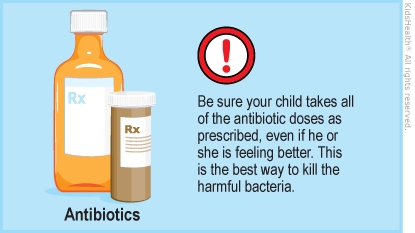Lyme Arthritis: How to Care for Your Child
Lyme arthritis is a symptom of Lyme disease, an illness caused by a type of bacteria (germ). The bacteria spread to humans through the bite of a tiny deer tick (also called a black-legged tick). In arthritis, a joint is inflamed (red, swollen, and painful). Lyme arthritis often goes away after treatment with antibiotics. Diagnosing and treating it early can help avoid problems later on.


-
Be sure your child takes the prescribed antibiotics for as long as instructed, even if feeling better.
-
Give your child anti-inflammatory medicine, like ibuprofen (such as Advil®, Motrin®, or a store brand) or naproxen (such as Aleve® or a store brand), if recommended by your health care provider.
-
Apply ice packs (with a towel between the ice and the skin) or heat to the joint as directed by your health care provider.
-
Encourage your child to stay active. Follow the health care provider's instructions for recommended exercises and activities.

Your child:
-
has problems taking the medicine
-
begins to have pain or swelling in other joints
-
feels worse
-
still has symptoms of arthritis after taking all of the antibiotics

What causes Lyme arthritis? Lyme arthritis happens after a person is bitten by a tick infected with the bacteria that cause Lyme disease. If the tick stays on long enough (1–2 days), it can transmit the germ. If the infection isn't treated, it can spread to different body parts, including joints. This can happen weeks or months after a tick bite, even if a person doesn't know that a tick bit them.
How is Lyme arthritis treated? Lyme arthritis is treated with oral (taken by mouth) antibiotics, usually for 28 days. If the antibiotics don't help, your child may get antibiotics again, either by mouth or intravenously (through an IV).
How can I protect my family from tick bites? Deer ticks live in tall grass and bushes. Follow these outdoor safety tips when you go into an area that may have ticks:
-
Teach kids to avoid sitting on the ground in wooded areas.
-
Have kids walk in the middle of the trail instead of going through high grass and woods.
-
Wear closed shoes, long-sleeved shirts, and long pants tucked into socks or boots. Wear light-colored clothing so ticks are easier to see.
-
Use insect repellent containing 10% to 30% DEET.
-
Consider treating clothing with permethrin to repel ticks. When used properly, it is safe for all ages. But don't use it on clothing or other material a child may suck on or chew.
-
Have kids shower and wash their hair after being outside to remove ticks before they attach.
-
Check kids all over for ticks after they return indoors.